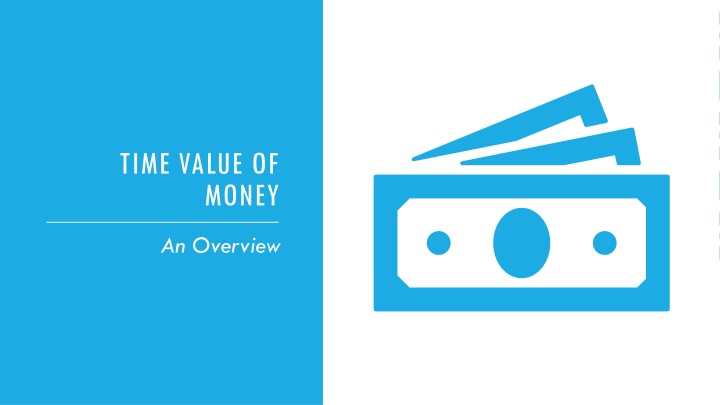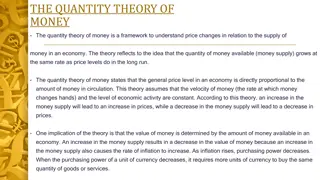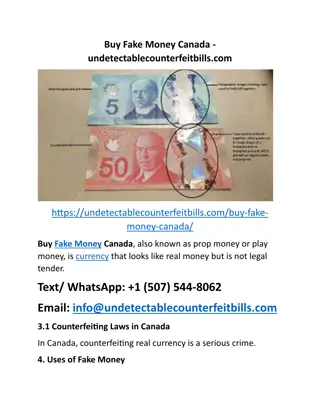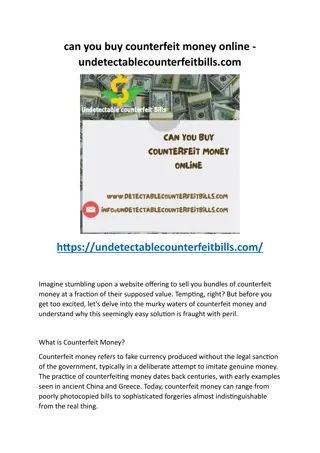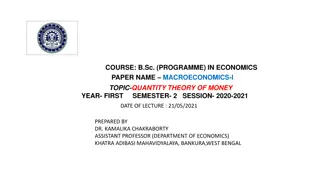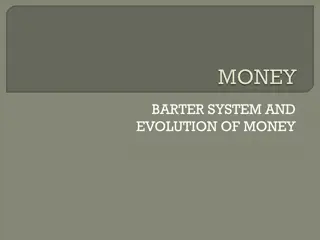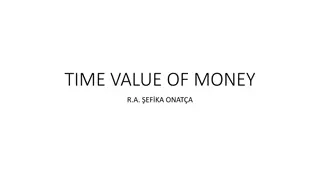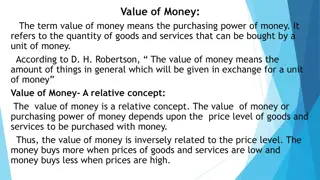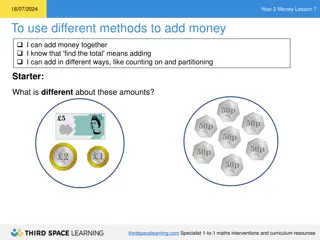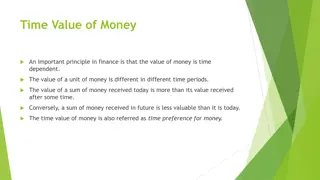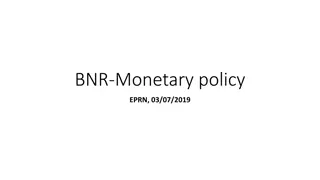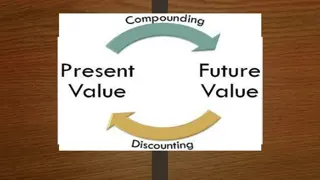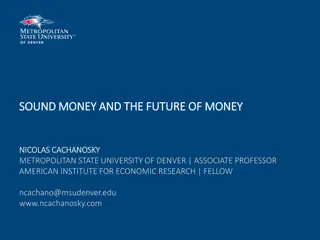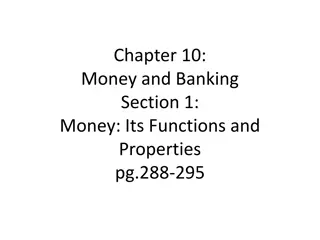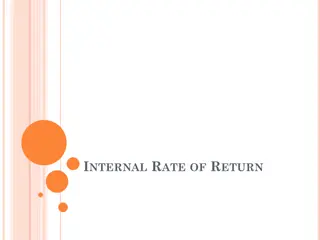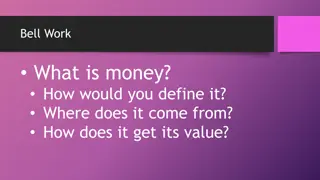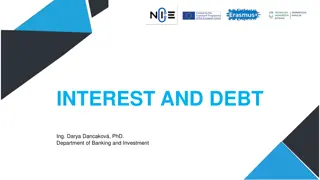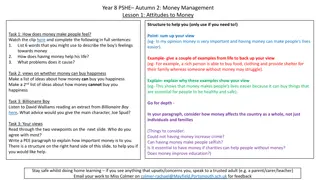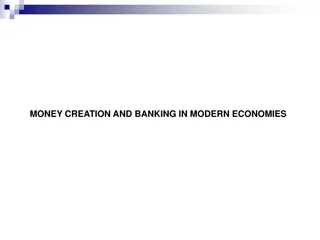TIME VALUE OF MONEY
Delve into the intricacies of time value of money, exploring its fundamental concepts and practical applications. Understand the significance of calculating present and future values, bringing clarity to financial decision-making and investment analysis. Grasp the essence of compounding interest and discounting cash flows to comprehend the importance of time in financial transactions. Unlock the secrets of maximizing returns and minimizing risks through strategic time value of money calculations.
Download Presentation

Please find below an Image/Link to download the presentation.
The content on the website is provided AS IS for your information and personal use only. It may not be sold, licensed, or shared on other websites without obtaining consent from the author.If you encounter any issues during the download, it is possible that the publisher has removed the file from their server.
You are allowed to download the files provided on this website for personal or commercial use, subject to the condition that they are used lawfully. All files are the property of their respective owners.
The content on the website is provided AS IS for your information and personal use only. It may not be sold, licensed, or shared on other websites without obtaining consent from the author.
E N D
Presentation Transcript
TIME VALUE OF MONEY An Overview
Present Value The amount an investment is worth today. Future Value The amount an investment is worth after one or more periods. TIME VALUE CONCEPTS Interest rate exchange rate between money today and money tomorrow Discount rate Cost of capital Opportunity cost of capital Required return
Show the timing of cash flows. Tick marks occur at the end of each period. Each tick mark corresponds to the end of one time period and the beginning of the next one. TIMELINES
SIMPLE INTEREST FV with simple interest The $1,000 investment accrues $50 each year for each of two years, So in 2 years you have: 1000 + 50 + 50 = 1,100
SIMPLE INTEREST FV with simple interest The $1,000 investment accrues $50 each year for each of two years, So in 2 years you have: Year 0 = (1,000) Year 1= 1000 + 50 = 1,050 Year 2 = 1000 + 50 + 50 = 1,100
COMPOUND INTEREST What is the future value of $1,000 after 2 years if the interest rate is 5% compounded annually? 1000 + 50 = 1,050 1,050 (1.05) =
COMPOUND INTEREST What is the future value of $1,000 after 3 years if the interest rate is 5% compounded annually?
FV: FORMULA METHODS After 1 year: FV1 = PV(1 + r) = $1,000(1.05) = $1,050.00 After 2 years: FV2 = $1,050.00(1.05) = $1,102.50 or FV2 = PV(1 + r)2 = $1,000(1.05)2 = $1,102.50 After 3 years: FV3 = 1,102.50(1.05) = $1,157.63 FV3 = PV(1 + r)3 = $1,000(1.05)3 = $1,157.63 After t years (general case): FVt = PV(1 + r)t
FUTURE VALUES: GENERAL FORMULA FV = PV(1 + r)t FV = future value PV = present value r = period interest rate, expressed as a decimal t = number of periods (time) Interest factor = (1 + r)t To find future values
FUTURE VALUES EXAMPLE 2 Suppose you invest the $1,000 at an interest rate of 5% for 10 years. How much would you have assuming compound interest? FV = PV(1 + r)t 1000 (1+.05)^10 = $1,628.89
FUTURE VALUE EXAMPLE 3 Suppose a relative of yours deposited $10 at 5% interest into a savings account 200 years ago. How much would the investment be worth today with simple interest? With compound interest? What is the difference? Simple 10 + 10 (0.5) (200) = 110 Compound FV = 10 (1+1.05) ^ 200 = 172,925.81
FV: USING EXCELS FINANCIAL TECHNOLOGY Type the formula Use a dialogue box Click on Formulas > Financial > FV. Fill in the Rate, number of periods (Nper), periodic payments (Pmt), and present value (Pv). Click OK. Type the function =FV(rate, nper, pmt, pv, type)
FV: EXCEL DIALOGUE BOX TECHNOLOGY If you invest $1000 for 5% per year how much money will you have in 3 years?
FV: EXCEL FORMULA Investment = CF0 = PV = Interest rate = I = No. of periods = N = -$1,000.00 5.00% 3 Periods: 0 | 1 | 2 | 3 | Cash Flow Time Line: -$1,000 FV = ? Step-by-Step Approach: $1,000 $1,050.00 $1,102.50 $1,157.63 Formula Approach: FVN = PV(1 + I)N FVN = $1000(1.05)3 = $1,157.63 Excel Approach: FV function: FVN = FVN = FVN = =FV(rate, nper, pmt, pv, type) =FV(0.05, 3, 0, -1000) = $1,157.63 =FV(C3, C4, 0, C2) = Fixed inputs: Cell references: $1,157.63
FUTURE VALUE ONE MORE EXAMPLE A company currently has profits of $3 million dollars. If profits increase 4% each year, how much profit will the company earn in 10 years?
FUTURE VALUE ONE MORE EXAMPLE A company currently has profits of $3 million dollars. If profits increase 4% each year, how much profit will the company earn in 10 years? 3mm , i=0.04 t = 10 FV = 3 (1.04) ^ 10
FUTURE VALUE ANOTHER EXAMPLE You borrow $10,000 in student loans your freshman year at an annual interest rate of 6.2% per year. If you have a grace year and don t have to start paying back the loan until after you graduate, how much money do you owe 5 years later?
FUTURE VALUE ANOTHER EXAMPLE You borrow $10,000 in student loans your freshman year at an annual interest rate of 6.2% per year. If you have a grace year and don t have to start paying back the loan until after you graduate, how much money do you owe 5 years later? PV 10,000, i=0.62, t= 5 10,000 * (1.062) ^5 = 13,508.98
FUTURE VALUE ONE MORE EXAMPLE If a stock which is currently worth $32 is expected to have return 8% annually, how much will it be worth in 5 years?
FUTURE VALUE ONE MORE EXAMPLE If a stock which is currently worth $32 is expected to have return 8% annually, how much will it be worth in 5 years? Pv = 32 I = 8.0% 47.02
PRESENT VALUE The amount an investment is worth today (now, at time 0). Finding the PV of a cash flow or series of cash flows is called discounting. The value of cash flows in today s purchasing power. 0 1 2 3 10% PV = ? 100
PRESENT VALUES We can use the future value formula to find the present value. FV = PV(1 + r)t Rearrange to solve for PV = FV / (1 + r)t To find present values
PV: THE FORMULA METHOD How much money must you invest today if you can earn 7% and you would like to have $5,000 in 10 years.
PV: THE FORMULA METHOD How much money must you invest today if you can earn 7% and you would like to have $5,000 in 10 years. 75.13
PRESENT VALUES EXAMPLE 2 Suppose when you were born, your parents wanted to begin saving for your college education and they estimated that after 17 years you would need $150,000. If they felt confident that they could earn 8% per year, how much did they need to invest when you were born?
PRESENT VALUES EXAMPLE 2 Suppose when you were born, your parents wanted to begin saving for your college education and they estimated that after 17 years you would need $150,000. If they felt confident that they could earn 8% per year, how much did they need to invest when you were born? 150,000 , 17 years 8.0% = 40,540.34
PRESENT VALUES EXAMPLE 3 You win a raffle and have the option of two prizes. You can either receive $1000 now or $1075 at the end of the year. If the discount rate is 8%, which prize do you prefer?
PV: USING EXCELS FINANCIAL TECHNOLOGY Type the formula Use a dialogue box Click on Formulas > Financial > PV. Fill in the Rate, number of periods (Nper), periodic payments (Pmt), and future value (Fv). Click OK. Type the function =PV(rate, nper, pmt, fv, type)
EFFECTS OF COMPOUND INTEREST For a given interest rate the longer the time period, the lower the present value. For a given time period the higher the interest rate, the smaller the present value
PRESENT VALUE How much money must you invest in an account that earns 8% today if you want to have $1000 in 5 years?
PRESENT VALUE How much money must you invest in an account that earns 8% today if you want to have $1000 in 5 years? PV = FV / (1+i) ^ t PV = 1000 / (1.08) ^ 5 = 680.53
PRESENT VALUE How much does a car cost in today s dollars if the dealer offers you a no money down 12% loan which requires full payment of $42,296.20 in 5 years?
PRESENT VALUE How much does a car cost in today s dollars if the dealer offers you a no money down 12% loan which requires full payment of $42,296.20 in 5 years? PV = 42,296.20 / (1.12)^5 = 24,000
REVIEW 1 If you invest $5000 in a savings account that earns 7% per year, how much will be in the account in 10 years?
REVIEW 1 If you invest $5000 in a savings account that earns 7% per year, how much will be in the account in 10 years? FV = pv (1+i)^t $9.835.76
REVIEW 2 How much money must you invest today if you can earn 7% and you would like to have $5000 in 10 years?
REVIEW 2 How much money must you invest today if you can earn 7% and you would like to have $5000 in 10 years? PV = ? 2541.75
REVIEW 3 You take a job and are offered the following payment options. If the discount rate is 8%, which option do you prefer
REVIEW 3 You take a job and are offered the following payment options. If the discount rate is 8%, which option do you prefer 1. $10000 paid in 2 years PV = 9,245.56 2. $12000 paid in 5 years PV = 9,863.13
BASIC DEFINITIONS - REVIEW Present Value The amount an investment is worth today. Future Value The amount an investment is worth after one or more periods. Interest rate exchange rate between money today and money tomorrow Discount rate Cost of capital Opportunity cost of capital Required return
PV EQUATION PV = FV / (1 + r)t There are four parts to this equation PV, FV, r, and t If we know any three, we can solve for the fourth
INTEREST RATE Suppose you buy a stock for $30 and sell it for $33 at the end of the year and also received $1 div. How much did you earn? Amount? Rate? 33 30 = 3 3/30 = 10% HPR% (holding Period Return) = CF / I = (33 -30 ) /30 = 3 / 30 = .10 = 10.)% (33-30+1)/ 30 = 4/30 = 13.3%
DISCOUNT RATE EXAMPLE 1 You are looking at an investment that will pay $1,200 in 5 years if you invest $1,000 today. How much interest does this investment earn? FV = PV (1+i)^t 33 = 30 (1+i)^1 33/30 = 30 (1+1+i) / 30 33/30 1= 10.0%
DISCOUNT RATE FORMULA Start with basic equation and solve for r FV = PV(1 + r)t
DISCOUNT RATE 1 t FV = 1 r PV
DISCOUNT RATE EXAMPLE 2 Suppose you have a 1-year old son and you want to provide $75,000 in 17 years toward his college education. You currently have $5,000 to invest. What interest rate must you earn to have the $75,000 when you need it?
DISCOUNT RATE EXAMPLE 2 Suppose you have a 1-year old son and you want to provide $75,000 in 17 years toward his college education. You currently have $5,000 to invest. What interest rate must you earn to have the $75,000 when you need it? R = (fv / pv ) ^ 1/t 1 = 17.27%
DISCOUNT RATE: USING EXCEL Type the formula Use a dialogue box Click on Formulas > Financial > RATE. Fill in the, number of periods (Nper), periodic payments (Pmt), present value (pv), and future value (Fv). Click OK. Type the function = RATE(nper, pmt, pv, fv, type, guess)
INTEREST RATE Suppose you buy a home for $300,000 and sell it 5 years later for $400,000. What yearly interest rate did you earn? PV = 300k, FV = 400k t = 5 I = (400/300) ^ 1/5 1 = 5.92%
